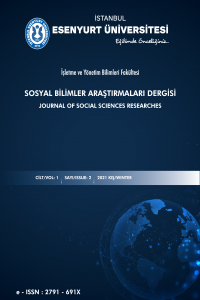SÜRÜDEKİ KURT: İÇ GİRİŞİMCİLİK VE ÖRNEKLERİ
İç girişimcilik, mevcut bir organizasyon içinde girişimciliği teşvik etme eylemini ifade eder. Çalışanları girişimci roller üstlenmeye ve yeni ürünler, hizmetler veya süreçler yaratmaya ve kendi kuruluşlarının sınırları içinde yeni iş modelleri geliştirmeye teşvik etme ve destekleme uygulamasıdır. İç girişimcilik, yeniliği teşvik etmek, yaratıcılık ve risk alma kültürü yaratmak ve kuruluşlar içinde büyümeyi yönlendirmek için kilit bir strateji olarak ortaya çıkmıştır. Bu araştırmanın amacı, iç girişimciliğin gelişimini, özelliklerini, faydalarını açıklamak, iç girişimciliği geleneksel girişimcilikten ayıran farklılıkları belirlemektir. Çalışma, bir kuruluş içinde iç girişimcilik kültürü yaratmanın önemini ve girişimcilerin/yöneticilerin böyle bir kültürü teşvik etme ve sürdürmede oynadıkları kritik rolü vurgulamaktadır. Ayrıca bu araştırma Türkiye ve Dünyadan güncel iç girişimcilik örnekleri sunarak keşfedici bir araştırma niteliği taşımaktadır. Çalışma ile, iç girişimciliğin, bir organizasyonun yenilikçi potansiyelini ortaya çıkarma ve çalışanların yaratıcılıklarını teşvik ederek şirket başarısını arttırmada önemli bir araç olduğu ortaya konulmuştur. Bu nedenle de, şirketlerin iç girişimciliğe önem vermesi, çalışanlarının fikirlerini dikkate alması ve bunları uygulamaya koyması, rekabet avantajı elde etmek için önemli bir adım olarak görünmektedir.
Anahtar Kelimeler:
iç girişimcilik, kurum içi girişimcilik, iç girişimcilik örnekleri, iç girişimciliğin önemi
WOLF IN THE FLOCK: INTRAPRENEURSHIP AND ITS EXAMPLES
Intrapreneurship refers to the action of promoting entrepreneurship within an existing organization. It involves encouraging and supporting employees to take on entrepreneurial roles and create new products, services, or processes, as well as developing new business models within the confines of their own organization. Intrapreneurship has emerged as a key strategy to promote innovation, create a culture of creativity and risk-taking, and guide growth within organizations. The aim of this research is to explain the development, characteristics, and benefits of intrapreneurship, and to identify the differences that set it apart from traditional entrepreneurship. The study emphasizes the importance of creating an intrapreneurial culture within an organization, and the critical role that entrepreneurs/managers play in promoting and sustaining such a culture. Additionally, this research provides exploratory insights into current examples of intrapreneurship from Turkey and around the world. Through work, it has been demonstrated that ıntrapreneurship is an important tool for revealing an organization's innovative potential and increasing company success by encouraging employee creativity. Therefore, it appears that companies placing importance on intrapreneurship, considering their employees' ideas, and implementing them is an important step towards gaining a competitive advantage.
Keywords:
intrapreneurship, corporate entrepreneurship, Examples of Intrapreneurship, İmportance Of Intrapreneurship,
___
- Ağca, V., & Yörük, D. (2006). Differences between independent entrepreneurship and intrapreneurship: A conceptual framework. Afyon Kocatepe Journal of Economics and Administrative Sciences, 8(2), 155-173.
- Antoncic, B., & Hisrich, R. D. (2001). Intrapreneurship: construct refinement and cross-cultural validation. Journal of Business Venturing, 16(5), 495-527.
- Aparicio, S., Turro, A., & Noguera, M. (2020). Entrepreneurship and intrapreneurship in social, sustainable, and economic development: Opportunities and challenges for future research. Sustainability, 12(21), 8958. Biçkin, P. G. (2020). Teknolojinin pazarlamadaki yeri ve yeni eğilimler: Pegasus Hava Yolları örneği (Master's thesis, Maltepe Üniversitesi, Sosyal Bilimler Enstitüsü).
- Burns, P. (2008). Corporate entrepreneurship. Palgrave Macmillan.
- Christensen, C. M. (2013). The innovator's dilemma: when new technologies cause great firms to fail. Harvard Business Review Press.
- Covin, J. G., & Miles, M. P. (1999). Corporate entrepreneurship and the pursuit of competitive advantage. Entrepreneurship theory and practice, 23(3), 47-63.
- Dees, J. G., & Anderson, B. B. (2006). Framing a theory of social entrepreneurship: Building on two schools of practice and thought. Research on social entrepreneurship, 1(1), 39-66.
- Elert, N., & Stenkula, M. (2022). Intrapreneurship: Productive and non-productive. Entrepreneurship Theory and Practice, 46(5), 1423-1439.
- Holt, D. T., Rutherford, M. W., & Clohessy, G. R. (2007). Corporate entrepreneurship: An empirical look at individual characteristics, context, and process. Journal of Leadership & Organizational Studies, 13(4), 40-54.
- İçerli, L., Yıldırım, M. H., & Demirel, Y. (2011). Kobilerde İç Girişimciliğin İncelenmesine Yönelik Bir Araştırma: Aksaray Örneği. Organizasyon Ve Yönetim Bilimleri Dergisi, 3(2), 177-187.
- Sánchez-Barrioluengo, M., & Benneworth, P. (2019). Is the entrepreneurial university also regionally engaged? Analysing the influence of university's structural configuration on third mission performance. Technological forecasting and social change, 141, 206-218.
- Senge, P. M. (1990). The fifth discipline: The art and practice of the learning organization. Doubleday/Currency.
- Smothers, C. (2019). The Rise of Intrapreneurship and How to Implement It in Your Business.
- Karasar, N. (2016). Bilimsel irade algı çerçevesi ile bilimsel araştırma yöntemi kavramlar ilkeler teknikler.(31. Basım). Ankara: Nobel Yayınları.
- Kaygın, E. (2012). Sürdürülebilir Bir Rekabet Avantajı Sağlamanın Yolu: İç Girişimcilik Anlayışı. Sosyal Ve Beşeri Bilimler Dergisi, 4(1), 93-103.
- Kuratko, D. F., & Audretsch, D. B. (2013). Clarifying the domains of corporate entrepreneurship. International Entrepreneurship and Management Journal, 9, 323-335.
- Laforet, K. (2013). Intrapreneurship: A Review of the Literature and Proposed Research Framework.
- Rule, E. G., & Irwin, D. W. (1988). Fostering intrapreneurship: The new competitive edge. The journal of business strategy, 9(3), 44.
- Veysel, A., & Yörük, D. (2006). Bağımsız Girişimcilik Ve İç Girişimcilik Arasındaki Farklar: Kavramsal Bir Çerçeve. Afyon Kocatepe Üniversitesi İktisadi Ve İdari Bilimler Fakültesi Dergisi, 8(2), 155-173.
- Viki, T., Toma, D., & Gons, E. (2020). The Corporate Startup: Wie etablierte Unternehmen erfolgreiche Innovationsökosysteme entwickeln können. Vahlen.
- https://www.anadolugrubu.com.tr/Upload/Docs/Anadolu_Group_Sustainability_Report_2021.pdf,Anadolu Group Sustainability Report,2021, (Erişim Tarihi: 15 Ocak 2023). (20% of their time to their own projects.
- https://static.googleusercontent.com/media/research.google.com/tr//pubs/archive/41469.pdf(Access Date: January 7, 2023).
- https://shiftdelete.net/arcelik-garage-innovation-hub-ile-citayi-yukseltti(Access Date: January 7, 2023).
- https://foreks.com/haber/detay/6268f5e346e0fb0001ad577a/FRKS/tr/turkcellin-girisimcilik-platformunun-dorduncu-donemi-icin-basvurular-basladi,Foreks, 2022, (Access Date: January 15, 2023.
- Başlangıç: 2021
- Yayıncı: İstanbul Esenyurt Üniversitesi
Sayıdaki Diğer Makaleler
SİVİL HAVACILIK KABİN HİZMETLERİ PROGRAMLARININ AKREDİTASYON SÜRECİ VE MESLEKİ İSTİHDAMDAKİ ÖNEMİ
AFET LOJİSTİĞİ ÜZERİNE KAVRAMSAL BİR İNCELEME
ANAYASA YARGISI VE UYGUNLUK DENETİMİ
THE NEW NORMAL'S NEW ENTREPRENEURSHIP: DIGITAL ENTREPRENEURSHIP
